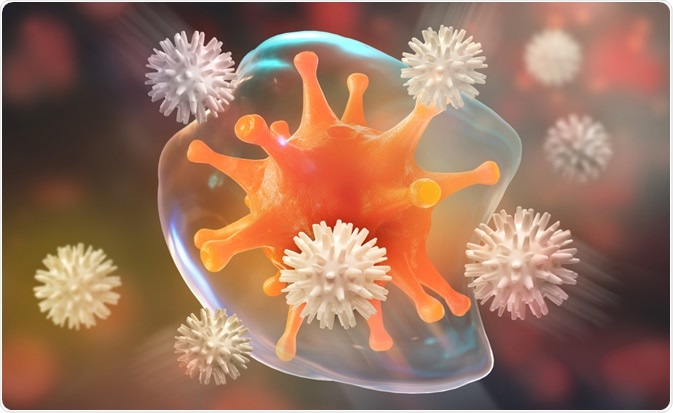benadryl allergy india
The human immune system is split into the innate immune system and the adaptive immune system. Both systems work in harmony to protect us from infections and disease. Here, we discuss their differences, as well as how they overlap and contribute to autoimmune diseases.

Image Credit: Yurchanka Siarhei/Shuttershock.com
The innate immune system
The innate immune system mediates the body’s response to antigens that enter the body. The evolution of this branch of the immune system has its roots dating back to the first multicellular organisms. It prevents pathogens from damaging the host by providing a line of immediate defense.
The innate immune system is a defense mechanism that acts within the first few hours of antigen invasion, involving the recruitment of physical barriers, including the skin, chemicals in the blood, and immune system cells that attack invading cells.
The properties of the foreign antigens invading the body induce the responses of the innate immune system, which has evolved to recognize pathogen-associated molecular patterns (PAMPs). To do this, it recruits germline-encoded pattern recognition receptors such as NOD-like, furocet headache pills RIG-1-like, and Toll-like receptors. PAMPs are specific to particular groups of microorganisms and usually represent non-protein molecules essential to the pathogens’ life cycles.
The innate immune system has the vital task of monitoring the body for PAMPs, distinguishing them from harmless antigens. An immune response is only triggered when necessary for potentially dangerous pathogens. Often, once the innate immune system is activated, it alerts the adaptive immune system, triggering a second immune response to enhance activity against invading pathogens.
The adaptive immune system
The adaptive immune system is responsible for triggering antigen-specific immune responses. It is more complex and intricate than the response of the innate immune system. The first stage of the adaptive immune system response involves processing and recognizing invading antigens. Once a foreign antigen has been identified, the adaptive immune system releases specific immune cells designed to destroy the antigen to protect the body from the proliferation of this potentially dangerous invader.
The adaptive immune system has a “memory” that allows future responses to previously recognized antigens to be faster and more efficient. Those who fall ill upon primary exposure to a pathogen may not fall sick on subsequent exposures or will have reduced symptoms as a result.
Compared to the innate immune system, the adaptive immune system usually takes several days to build a sufficient and effective response following invading pathogen recognition. While it does this, memory lymphocytes are made that give the adaptive immune system its “memory”.
The closeness of the innate and adaptive immune system and autoimmunity
Initially, scientists viewed the innate and adaptive immune systems as distinct entities with little in common. However, new research into the basis of autoimmune responses demonstrates that their mechanisms may overlap. Understanding the closeness of the two systems may be vital to preventing and treating autoimmune diseases.
Scientists have long theorized that infections may induce autoimmune diseases. Examples with strong empirical backing include the relationship between chlamydial infections and heart disease, and the association between Coxsackie virus infection and type I diabetes.
There are suggestions that pathogens have the potential to induce autoimmunity via molecular mimicry. It is hypothesized that they have the potential to share T or B cell epitopes with the host, resulting in inducing a self-specific immune response when a person is infected with the pathogen.
This cross-reactivity between self-derived and pathogen-derived antigens is one cause of infection-induced autoimmunity involving the adaptive immune system. However, more recent evidence has revealed that bystander T cell activation could also play an important role.
Self-antigens are produced as cells are damaged as a result of infection. Macrophages and dendritic cells then take up and process these self-antigens. At the same time, antigen-presenting cells are activated, increasing their ability to process antigens, upregulating the expression of costimulatory molecules, and inducing their migration to secondary lymphoid organs where they prime the responses of T cells.
Interestingly, the nonspecific triggering of the dendritic cells, inducing their maturation program, is not only caused by pathogen-derived structures. T cells secrete factors that trigger the maturation program of dendritic cells in lymphoid organs during the time of a viral infection. This evidence demonstrates the closeness of the innate and adaptive immune systems, showing that they are not entirely distinct. It also supports the theory that both systems can be responsible for autoimmunity.
References
- 2013. Oxford Textbook of Rheumatology. https://oxfordmedicine.com/view/10.1093/med/9780199642489.001.0001/med-9780199642489-chapter-48
- Bachmann, M. and Kopf, M., 2001. On the Role of the Innate Immunity in Autoimmune Disease. Journal of Experimental Medicine, 193(12), pp.F47-F50. https://www.ncbi.nlm.nih.gov/pmc/articles/PMC2193298/
- Immunobiology: The Immune System in Health and Disease. 5th edition. NCBI. Available at: https://www.ncbi.nlm.nih.gov/books/NBK27090/
Further Reading
- All Immunology Content
- What is Immunology?
- Classical Immunology
- Clinical Immunology
- Developmental Immunology
Last Updated: Aug 6, 2021

Written by
Sarah Moore
After studying Psychology and then Neuroscience, Sarah quickly found her enjoyment for researching and writing research papers; turning to a passion to connect ideas with people through writing.
Source: Read Full Article
